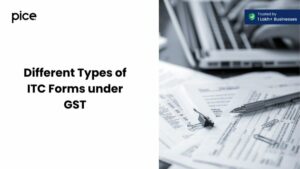GST Rate for Suitcases and Handbags
- 20 Sep 24
- 12 mins

GST Rate for Suitcases and Handbags
Key Takeaway
- Suitcases, travel bags, handbags, wallets, and leather bags are taxed at a GST rate of 18%, classified as non-essential luxury items.
- The GST rate significantly affects the retail pricing of these items, making them more expensive for the consumer.
- Accurate application of GST is crucial for businesses to ensure compliance, avoid penalties, and maintain transparent pricing.
- For packaging materials like jute bagging and shopping bags, GST rates can vary based on the material composition and environmental impact.
- Consumers and businesses must stay informed about changes in GST rates and regulations to effectively manage purchasing and pricing strategies.
GST Rate for Suitcases and Travel Bags
When planning a trip, one of the essentials that often comes to mind is a reliable suitcase or travel bag. These items not only make travel more convenient but also ensure that your belongings are secure during your journey. However, it's important for consumers and businesses alike to understand the tax implications associated with purchasing these travel essentials.
Current GST Rate
As of the latest updates, suitcases and travel bags are subjected to a GST (Goods and Services Tax) rate of 18%. This rate applies to a variety of products in this category, including:
- Hard and soft suitcases
- Rolling luggage
- Duffle bags
- Large travel backpacks
Classification Under GST
The classification of these items under the GST regime is straightforward. Suitcases and travel bags are considered non-essential luxury items, which is why they attract a higher GST rate of 18%. This classification aligns with the government's policy to levy higher taxes on luxury goods compared to essential items.
Impact on Prices
The GST rate of 18% significantly affects the retail price of suitcases and travel bags. For consumers, this means that the cost of purchasing new luggage can be considerably higher due to the tax rate. It is essential for buyers to factor in this additional cost when planning their travel budgets.
Business Implications
For businesses dealing in the sale of suitcases and travel bags, understanding and applying the correct GST rate is crucial for compliance. It ensures that the business is not undercharging or overcharging the GST, which could lead to penalties or losses respectively. Businesses must keep updated with any changes in the tax rates or regulations announced by the GST council to remain compliant.
GST Rate for Handbags and Wallets

Handbags and wallets are indispensable accessories for many people, combining functionality with fashion. Whether you're looking for a practical item for everyday use or a stylish accessory to complete an outfit, understanding the financial implications, such as the applicable Goods and Services Tax (GST), is crucial for both consumers and businesses.
Current GST Rate
As of the latest guidelines, handbags, including purses and wallets, attract a GST rate of 18%. This rate applies across various materials and styles, encompassing everything from luxury designer handbags to more utilitarian wallets.
Overview of GST Classification
Handbags and wallets are categorized under the same GST slab as many other fashion accessories, which is set at a higher rate of 18%. This classification is based on the view that these items are non-essential luxury goods. Therefore, they are taxed at a higher rate compared to essential commodities, which are taxed at lower rates or might even be exempt from GST.
Impact on Consumer Pricing
The GST rate of 18% on handbags and wallets can significantly affect the final retail price, making these items more expensive for the consumer. This tax component is directly added to the cost base of the product, and ultimately, it is the consumer who bears this tax burden. It's important for buyers to consider this tax when planning purchases, especially for more expensive or branded items.
Implications for Retailers and Manufacturers
For retailers and manufacturers of handbags and wallets, accurately applying the GST rate of 18% is critical for compliance with tax laws. Proper GST application ensures transparent pricing for consumers and helps maintain the integrity of business operations. Retailers must also stay informed about any changes in the GST rates or related tax policies to manage pricing strategies effectively and maintain compliance.
Key Considerations
- Pricing Strategy: Businesses need to incorporate the GST effectively in their pricing strategy to avoid impacting sales negatively while ensuring compliance with the law.
- Consumer Awareness: Consumers should be aware of the GST rates when shopping for handbags and wallets to understand better the breakdown of their expenditures.
GST Rate for Leather Bags
Articles of leather are a popular accessory choice, known for their durability and style. Understanding the Goods and Services Tax (GST) applicable to leather bags is important for both consumers and businesses, as it impacts pricing and compliance with tax laws.
Current GST Rate
The GST rate for leather bags currently stands at 18%. This rate applies to all types of leather bags including handbags, backpacks, briefcases, and other similar products made primarily from leather.

Overview of GST Classification
Leather bags are classified under the broader category of goods that are considered non-essential luxury items. The GST system places such items in higher tax brackets, reflecting their status as more of a luxury than a necessity. The classification under GST is consistent with the government's approach to impose higher taxes on luxury goods.
Impact on Pricing
The GST at 18% significantly affects the retail cost of leather bags. For consumers, this means that the price paid at checkout includes a substantial tax component. This higher rate can make leather bags more expensive, but it also reflects the quality and longevity typically associated with leather products.
Business Compliance
For businesses dealing in leather bags, applying the correct GST rate of 18% is crucial. Accurate tax application ensures compliance with tax laws and prevents any potential legal issues. Businesses need to factor in this tax when setting prices and managing invoices to ensure transparency and compliance.
GST Rate for Jewellery Boxes

Jewellery boxes are not only functional, used for the safekeeping of precious items, but often are also crafted to be aesthetically pleasing. The GST (Goods and Services Tax) rate applied to jewellery boxes in India varies based on the material and purpose of the box.
Current GST Rate
Jewellery box GST rate is 18%. This rate is applicable to most types of jewellery boxes, regardless of whether they are made from wood, metal, plastic, or any other material. The rate reflects the classification of these items as non-essential luxury goods.
Overview of GST Classification
The classification under GST for jewellery boxes as non-essential luxury items places them in one of the higher tax slabs. This categorization is consistent with the overall approach of the GST system, which aims to levy higher taxes on luxury items compared to essential goods.
Impact on Pricing
The application of an 18% GST affects the final retail price of jewellery boxes significantly. This tax component is added to the base price, making these items costlier for the consumer. Understanding this tax implication is crucial for buyers, particularly when purchasing high-end or designer jewellery boxes.
Business Compliance
For retailers and manufacturers of jewellery boxes, it is important to correctly apply the 18% GST rate to ensure compliance with tax regulations. Misapplication of the GST rate can lead to tax discrepancies and potential penalties. Businesses must remain vigilant about any updates or changes to the GST rates and regulations to maintain compliance and transparency in their pricing.
Current GST Rate
Jewellery boxes typically fall under a GST rate of 18%. This rate is applicable to most types of jewellery boxes, regardless of whether they are made from wood, metal, plastic, or any other material. The rate reflects the classification of these items as non-essential luxury goods.
Overview of GST Classification
The classification under GST for jewellery boxes as non-essential luxury items places them in one of the higher tax slabs. This categorization is consistent with the overall approach of the GST system, which aims to levy higher taxes on luxury items compared to essential goods.
Impact on Pricing
The application of an 18% GST affects the final retail price of jewellery boxes significantly. This tax component is added to the base price, making these items costlier for the consumer. Understanding this tax implication is crucial for buyers, particularly when purchasing high-end or designer jewellery boxes.
Business Compliance
For retailers and manufacturers of jewellery boxes, it is important to correctly apply the 18% GST rate to ensure compliance with tax regulations. Misapplication of the GST rate can lead to tax discrepancies and potential penalties. Businesses must remain vigilant about any updates or changes to the GST rates and regulations to maintain compliance and transparency in their pricing.
| Category | GST Rate | Classification | Impact on Prices | Business Implications |
|---|---|---|---|---|
| Suitcases and Travel Bags | 18% | Non-essential luxury items | Higher retail prices due to luxury tax; consumers should factor this into budgeting for travel needs. | Compliance is crucial; businesses must update pricing strategies. |
| Handbags and Wallets | 18% | Non-essential luxury items | Increases the final retail price; significant for more expensive, branded items. | Accurate application of GST ensures compliance and transparent pricing. |
| Leather Bags | 18% | Non-essential luxury items | Higher retail cost due to substantial tax component; reflects quality and durability. | Correct GST application is critical for legal and financial compliance. |
| Jewellery Boxes | 18% | Non-essential luxury items | Elevated cost at retail due to the high GST rate; affects purchasing of high-end products. | Proper GST rate application is essential to avoid penalties. |
💡If you want to pay your GST with Credit Card, then download Pice Business Payment App. Pice is the one stop app for all paying all your business expenses.
Understanding HSN Codes for Bags
The Harmonized System of Nomenclature (HSN) codes are internationally standardized codes for the classification of products. These codes are crucial for identifying products during import, export, and within domestic markets for purposes such as taxation. Here, we'll explore the HSN codes related to different types of bags, including general bags, backpacks, and specifically, nylon backpacks.
HSN Code for Bags
For general categorization, bags typically fall under the HSN code 4202. This code encompasses a wide range of bag types, including handbags, travel bags, and various other forms of container bags made from different materials. It's a broad category that covers:
- Suitcases
- Briefcases
- Handbags
- School bags
- Travel bags
HSN Code for Backpack
Backpacks, which are designed for carrying on the back and are commonly used by students and hikers, also fall under the HSN code 4202. More specifically, they are often listed under 4202 92, which refers to bags with outer surfaces of textile materials, a common characteristic of many backpacks.
HSN Code for Nylon Backpack
Nylon backpacks, due to their specific material composition, are classified under 4202 92 20. This HSN code is designated for backpacks made from nylon or other synthetic textiles, focusing on the type of material used. This sub-classification helps in distinguishing nylon backpacks from those made of other materials for taxation and regulatory purposes.
HSN Code for Packaging Bags
Packaging bags, which are used for wrapping or protecting goods, typically fall under several HSN codes depending on the material:
- HSN 3923: This code is used for plastic packaging bags. It covers articles for the conveyance or packing of goods, of plastics, including stoppers, lids, caps, and other closures.
- HSN 6305: This code covers sacks and bags, of a kind used for the packing of goods, made from man-made textile materials.
HS Code for Box Packaging
Box packaging generally refers to boxes used for the safe transport or storage of various items. These boxes can be made from a range of materials, including paper, cardboard, and corrugated materials:
- HS Code 4819: This code includes cartons, boxes, cases, bags, and other packing containers made of paper, paperboard, cellulose wadding, or webs of cellulose fibers; box files, letter trays, and similar articles, of paper or paperboard.
HS Code for Postal Bags
Postal bags, designed specifically for mailing and sorting mail, also vary by material:
- HS Code 3923: This includes postal bags made of plastics.
- HS Code 6305: This covers postal bags made from textile materials.
 By
By 
















